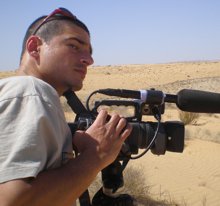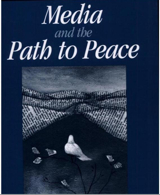
Recently, MediaShift started running reports from correspondents and embeds around the world. This report comes from Jaron Gilinsky, a journalist and documentary filmmaker in Jerusalem.
JERUSALEM — Blogs exemplify the best and worst attributes of the Internet (and human nature). At their worst, blogs can be untruthful, bad sources of news and gossip. But without the profit motive, the need for immediacy, and the thirst for conflict, blogs can also help show a more complete picture of the Middle East. At their best, they can be a great source of anti-news and help demystify this murky region.
If you can find the good blogs, you will be exposed to a very real slice of Middle Eastern reality that wasn’t possible 10 years ago. And that slice of life is more than just suicide bombings, radicalism and ethnic strife — which most outsiders assume is what we encounter every day living here.
It’s always an enlightening experience leaving Jerusalem to visit my hometown of Miami, Florida. Based on numerous encounters with fellow Americans, I inevitably learn many new things that I never knew about the Middle East. I learn that there are bullets whizzing through the air at all times. I learn that there are bombs exploding in a crowded market right now as you read this. And I learn that I am totally insane for choosing, under my own free will, to live in the Middle East.
I actually feel quite safe living in the city of Jerusalem. Yes, there is tension and ethnic strife. And yes, there is violence here, but it is rare and isolated. It is really no different than living in Miami, where incidentally I have been held up at gunpoint, knifepoint, and have been beaten up by thugs.

A month or so ago, just down the street from my Jerusalem apartment, a construction worker used a bulldozer to kill and maim people. That may have been the most dangerous civilian encounter I’ve had in 7 years in the region, and it wasn’t even that close. True, life in Gaza City, Sderot, and Baghdad are not pictures of serenity. I don’t suggest vacationing in those hotspots, but I also don’t recommend walking through certain neighborhoods in many U.S. cities.
The numbers don’t lie. Take the year of 2006 as an example. Israel was fighting and being attacked on two fronts in Lebanon and Gaza. Still, comparative homicide rates make Israel seem like Disney World compared with many U.S. cities. That year Israel had 5.4 deaths due to war, terrorism, and crime per 100,000 citizens, according to Israeli government statistics. Metropolitan Miami, on the other hand, had 19.6 homicides per 100,000 citizens during that same year, according to the FBI’s accounting.
Even in the densely populated and seemingly dangerous Gaza Strip, which was frequently bombed by the Israeli Air Force, the percentage of people killed was on par with that of “Charm City,” Baltimore, Maryland, the murder capital of America. (Those numbers come from Palestinian Authority figures, Btselem Human Rights Organization, and the FBI.)
Media Feeding Misconceptions
So why is the average American’s perception of the Middle East so negative? Well, the answer is obvious. The media is to blame. If you’ve never visited a place, and don’t know anyone who has, then your perception of that place comes solely from the media. And the media seems obsessed with violence, not just in the Middle East, but wherever it may rear its ugly head.
“If it bleeds, it leads,” is the old adage in U.S. newsrooms. When was the last time you read an article or saw a report about the country of Jordan? Yes, it still exists. In case you’ve never heard of Jordan, it is a relatively peaceful monarchy with about 6 million people, sandwiched between Israel and Palestine on one side, and Iraq on the other. It is prospering, in reality, but with so much action going on all around it, the story of Jordan’s recent business development and economic growth is overshadowed by more “newsworthy” stories.
“Peace isn’t sexy,” said Gadi Wolfsfeld, a Hebrew University communications professor, MIT grad, and expert on media and the Middle East, “and that’s one reason peace journalism doesn’t sell papers.”

This was the first I’d heard of the concept of “peace journalism,” which is not as simple as it sounds. It constitutes, in a nutshell, both an editorial shift to more stories of peacemaking and co-existence, as well as an entirely new framework for reporting about conflict. According to Wolfsfeld’s fascinating book, “Media and the Path to Peace,” news reporting does more than just shape perceptions abroad. It is also a key factor in determining the region’s ability to make peace with itself. In this respect, journalism is failing the Middle East.
Besides profit, Wolfsfeld breaks down three other incompatibilities that prevent journalism from delving too deeply into the peace arena. News is immediate. It is about what’s happening right now. Peace is as slow as molasses. News is about drama. Conflict has lots of drama. Peace, on the other hand, is usually boring.
Finally, news reporting, especially in local, non-international media, is often ethno-centric. This region is a great example. Story selection and editorial lines in Israeli and Palestinian news outlets are generally miles apart. The “other” is usually the perpetrator, whereas “your side” is generally the victim. Even reporting about the same events can lead you to think you’re reading about two separate events due to the inconsistent terminology, narratives, and facts on the ground. Traditional conflict journalism does more than just affect perceptions abroad. It also perpetuates the conflict locally.
Can New Media Make a Difference?
The real question is whether the proliferation of high speed Internet connections, digital cameras, and user-friendly blog publishing tools can change the game. There are now countless blogs in Arabic, Hebrew, Farsi, Kurdish, and English — each with its own unique style and perspective. Peace blogs are becoming more and more prevalent.
Life Must Go On In Sderot and Gaza is a blog written by two anonymous voices for peace, one an Israeli from the city of Sderot, another a Palestinian from the Sajaia refugee camp in Gaza. There is also EMS Peace, a personal blog written by an Australian surfing expat, now a peace activist living in Jaffa. He uses his blog both for his own cathartic release, and to reach out to a small, but growing niche of peace activists in the region.
The blog is also becoming a tool for free speech in a region where media is sometimes controlled or intimidated by the government. When a story leaked that incriminated the Bahraini government, the only person that would touch it was a 30-year-old blogger named Ali Abduleman. Although Ali has spent some time in jail for blog posts that insulted the monarchy, it hasn’t stopped him from running Bahrain Online, a web hub for the Bahraini blogging community.

There have been numerous reports of bloggers being arrested in Egypt and Syria, but none recently. It still remains to be seen whether governments are even capable of censoring the limitless amount of information that exists on the Internet, which is by its very nature an unstoppable grassroots force. I am surprised the Egyptian government hasn’t questioned this English language blog, Baheyya, a reasoned voice that regularly reports on anti-government protests and acts of civil disobedience against Hosni Mubarak’s government. Perhaps governments are realizing their limitations in this age of information run amok.
“If you can’t beat ‘em, join ‘em” should be the new motto for governments concerned with keeping citizens informed. Instead of plucking out thousands of frail and frightened bloggers from their basements, why not incorporate a blog into your propaganda machine and then just use it as a cyber-steamroller to counter your dissidents? An interesting new development is the use of blogs by politicians and world leaders. Iranian President Mahmoud Ahmadinejad has even entered the blogosphere, with a personal blog available in four languages that he promises to write for 15 minutes each day.
As more readers move away from print, mainstream newspapers are beefing up their online media sections. The LA Times has a fascinating “behind the scenes” blog written by their Middle East correspondents called Babylon and Beyond. The style of this blog seems to be in step with a different type of news consumer. Its news stories are shorter, more visual, not so hard, and not so bloody. Whether you’re a jihadist or a peacenik, an Egyptian Coptic Christian or a Lebanese Druze, a journalist or a conspiracy theorist, there is probably an existing blog written by someone like you in the Middle East. If not, just wait a couple years and chances are there will be.
Professor Wolfsfeld, who is now doing research on new media, told me that the trouble with blogs is that “there are more people writing them today than there are reading them.”
Wolfsfeld’s use of hyperbole was to emphasize that, despite their meteoric rise in recent years, new media still has a lot of catching up to do with respect to the number of readers that still frequent the mainstream media. Still I do suspect the gap is closing, and as that gap closes, I suspect the perception gap surrounding the Middle East will also close. Maybe one day I will come visit Miami and people will call me crazy for ever leaving the Middle East.
Jaron Gilinsky is a journalist and documentary filmmaker based in Jerusalem. Jaron is the founder and editor of Falafel TV, a breakthrough Middle East video cooperative. As a freelance video correspondent for Current TV, CNN World Report, and the New York Times, he has produced and directed scores of documentaries on a range of international topics. Jaron regularly posts his videos and articles on his personal blog.
Photo of Museum of Jerusalem by Viktor Kaposi via Flickr.

I think most intelligent people would question the surprisingly low figures for violent deaths in Israel and the Gaza Strip. The murder rate you gave for Miami was for the puny core city, the metropolitan area’s rate is 7 per 100,000. I notice you left out Baghdad in your comparison after giving the impression American cities were comparable. For 2006, the Baghdad area’s murder rate was 267 per 100,000 and that’s not including soldiers or police.
Here are more complete numbers: http://israel-like-this-as-if.blogspot.com/2007/11/violent-death-updating-us-israel.html – it also contains links to some data sources if you want to verify these numbers. The show that Israel-as-a-whole is somewhat safer than the USA-as-a-whole.
I totally agree with your point of view. Actually, my goal, as a future journalist, it´s to create a magazine only with good news. However, everytime that I say this to someone, the answer that I hear is, “Peace doesn´t sell, war sells”, and, infortunely, like you said on your article, it´s the truth.
Anyhow, I still have hopes about the news. I still believe that it will be possible to create peace. But first, the human kind have to change, than we can change the news…
Do you have contact information for beheya?